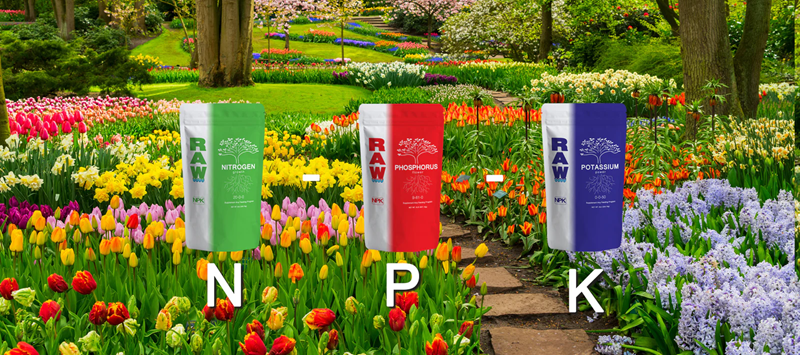Hortimix Nutrient Preparation and Usage Table
Mix 525g of Part A with 5 liters of fresh water in a container, label and shake until dissolved.
Do the same with the 350g of Part B in another 5 liter container, label, and shake well.
Monopotassium phosphate, MKP, KH₂PO₄ – Mix 125g in 5L of water and the follow attached table.
Store in a cool dark place.
Follow Feeding schedule on page 2 for the correct dosage or follow the instructions below to use the solutions you have made to feed your plants!
During the vegetation cycle always use equal quantities of both Part A and Part B nutrient to reach the required E.C. value. One week into the flowering cycle, 20% of the required volume of Part A should be replaced with MPK. This value can gradually increase to 40% by volume in the case of large plants. The E.C. values on the table are calculated using 1 liter of pH balanced water as the measuring standard with a base E.C. of less than 0.1.
The values are estimations only and this table can be used as a general guide.
When making up the nutrients solution, you should add the nutrients and adjust the pH afterwards with the pH Up or PH Down to get the desired pH of between pH 5.5 – 6.5. Avoid using pH Up and pH Down too many times in one solution as this can cause the pH to become unstable.
Schedule to be used as a weekly Feeding schedule.
It is best to give the plants new water and Nutrients at each stage (week).
Alternatively, you could use an EC Meter.
An EC meter measures the electrical conductivity in the water (the amount of nutrients), then you can adjust the water/Nutrients to the correct EC per growing Stage.
Lettuce can handle a maximum EC of about 1.2. Therefore you would not go beyond an EC of 1.2 for Lettuce, you would continue feeding the same amount of Nutrients for an EC of 1.2 for each additional week that your plants are in your system.
Tomatoes can handle an EC of 2 to 5, therefore you can go right to the end of the Feeding schedule and beyond (increasing in same increments). Try grow plants with similar EC and pH range. If you are growing for example, Lettuce and Tomatoes together, harvest your lettuce before you increase nutrients to a higher range otherwise your lettuce will get Nutrient burn (edges of leaves brown) if the Nutrient level is too high.
Please see optimum pH and EC readings for various types of plants and vegetables on our website Hydroponic.co.za. Click on the heading ‘Hydroponics’ and then on ‘Plant PH/EC/PPM’.
Never mix the nutrients together in their concentrated form, as this will cause nutrient “lock-out” making some minerals unavailable. It is best to begin by adding Nutrient A, stirring well, and then Nutrient B and stir well etc
Recommended feeding Schedule and Estimated E.C. Values
Amounts below per 1 liter of water:
| Part A | Part B | MPK | E.C. | Recommended Feeding | |
| Week 1 | 1 ml | 1 ml | 0.2 | Established Seedlings | |
| Week 2 | 2 ml | 2 ml | 0.4 | These values are good for advanced seedling stage and also for early clones | |
| Week 3 | 3 ml | 3 ml | 0.6 | ||
| Week 4 | 4 ml | 4 ml | 0.7 | ||
| Week 5 | 5 ml | 5 ml | 0.8 | ||
| Week 6 | 6 ml | 6 ml | 1.0 | Good values for full growing and early flowering | |
| Week 7 | 7 ml | 7 ml | 1.1 | ||
| Week 8 | 6 ml | 8 ml | 2 ml | 1.2 | |
| Week 9 | 7 ml | 9 ml | 2 ml | 1.3 | These values are for mid flowering stages |
| Week 10 | 7 ml | 10 ml | 3 ml | 1.4 | |
| Week 11 | 8 ml | 11 ml | 3 ml | 1.5 | |
| Week 12 | 8 ml | 12 ml | 4 ml | 1.6 | |
| Week 13 | 9 ml | 13 ml | 4 ml | 1.7 | Full flowering will require even greater nutrition but always monitor carefully |
| Week 14 | 9 ml | 14 ml | 5 ml | 1.8 | |
| Week 15 | 10 ml | 15 ml | 5 ml | 1.9 | |
| Week 16 | 11 ml | 16 ml | 5 ml | 2.0 |
Enjoy Growing!






